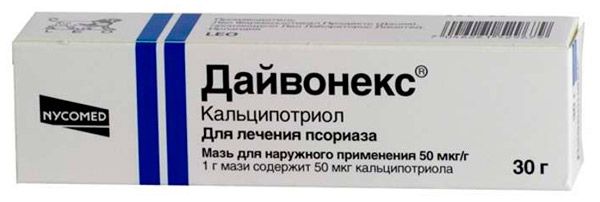Medical expert of the article
New publications
Preparations
Daivonex for psoriasis
Last reviewed: 03.07.2025

All iLive content is medically reviewed or fact checked to ensure as much factual accuracy as possible.
We have strict sourcing guidelines and only link to reputable media sites, academic research institutions and, whenever possible, medically peer reviewed studies. Note that the numbers in parentheses ([1], [2], etc.) are clickable links to these studies.
If you feel that any of our content is inaccurate, out-of-date, or otherwise questionable, please select it and press Ctrl + Enter.

Indications Dyvonexa for psoriasis
Indications for the use of Daivonex in psoriasis - treatment of plaque psoriasis rashes of mild and moderate degrees in the stationary and regressive stages of the disease.
Release form
The drug Daivonex for psoriasis has the following dosage forms: ointment (in tubes of 30 and 100 g), cream (in tubes of 30 and 100 g), solution (in PE bottles of 60 ml).
 [ 3 ]
[ 3 ]
Pharmacodynamics
The pharmacodynamics of all dosage forms of Daivonex for psoriasis is based on the suppression of the process of hypertrophic proliferation of keratinocytes and regulation of their differentiation by the active substance calcipotriol (1,25-dihydroxy-D3) - a bioactive synthetic form of vitamin D, which is a selective regulator of the human immune system and an inhibitor of the development of autoimmune diseases.
Calcipotriol is a secosteroid substance with a molecular structure similar to sterols. It acts as a modulator of vitamin D3 nuclear receptors (VDR) of cells of the cambial layer of the skin (stratum cambiale), which ensures the growth and regeneration of the epidermis; mononuclear leukocytes of the peripheral blood (monocytes with phagocytic activity), as well as T-cells - T-lymphocytes, which determine and regulate the body's immune response.
By binding to the VDR of epidermal cells, the active substance Daivonex blocks the protein cathelicidin (LL-37), which reduces the activity of dendrocytes (Langerhans cells) and mitosis of keratinocytes. And the interaction of calcipotriol with the receptors of vitamin D T-cells leads to the normalization of the synthesis of thymus-stromal lymphopoietin (TSLP), which plays an important role in the maturation of inflammatory cytokines.
 [ 4 ]
[ 4 ]
Pharmacokinetics
When Daivonex is applied to the skin for psoriasis, systemic absorption of calcipotriol does not exceed 4-5%.
1,25-dihydroxy-D3 is broken down by liver enzymes into less active alpha- and beta-unsaturated ketone metabolites, which are slowly metabolized into calcitroic acid. All biotransformation products of the drug that has entered the bloodstream are excreted through the kidneys and intestines.
Dosing and administration
Daivonex ointment and cream are applied to psoriatic spots in a very thin layer (without rubbing into the skin) - once or twice a day. No more than 15 g of ointment or cream can be used per day. The standard course of treatment is two months.
Daivonex in solution form is used in case of scalp lesions; one bottle (60 ml) should be enough to treat the scalp for a week.
Neither ointment (or cream) nor solution is used to treat spots on the skin of the face.
The official instructions also note the need to thoroughly wash your hands after using Daivonex.

 [ 9 ]
[ 9 ]
Use Dyvonexa for psoriasis during pregnancy
Since the safety of this drug during pregnancy has not been studied, using Daivonex for psoriasis during pregnancy is not recommended.
Side effects Dyvonexa for psoriasis
Side effects of Daivonex for psoriasis include increased dryness and itching of the skin, hypersensitivity to sunlight, changes in pigmentation, increased calcium levels in the blood and urine. Eczema or exacerbation of psoriasis may develop.
 [ 8 ]
[ 8 ]
Overdose
Most often, an overdose of this drug is associated with its more frequent use or with application to large areas of the skin. If the dosage is violated, signs of increased calcium levels in the blood may be noted: muscle weakness, intense thirst, loss of appetite, nausea, vomiting, constipation, a state of general lethargy. In such cases, the use of Daivonex is discontinued.
Storage conditions
Doctors' reviews
Since the mid-1980s, numerous studies of the effectiveness of ointments with calcipotriol in topical therapy of psoriasis have been conducted in domestic and foreign dermatology, and clinical trial reports have been published in specialized medical journals.
Reviews from dermatologists indicate: Daivonex for psoriasis - thanks to the action of calcipotriol - helps reduce the severity of rashes after just one week of use. After two weeks, in almost 12% of cases, plaques become smaller and do not protrude above the surface of the skin, and the intensity of their peeling also decreases. And the result of using this drug for 30-40 days can be a long-term remission of mild to moderate psoriasis.
Attention!
To simplify the perception of information, this instruction for use of the drug "Daivonex for psoriasis" translated and presented in a special form on the basis of the official instructions for medical use of the drug. Before use read the annotation that came directly to medicines.
Description provided for informational purposes and is not a guide to self-healing. The need for this drug, the purpose of the treatment regimen, methods and dose of the drug is determined solely by the attending physician. Self-medication is dangerous for your health.

